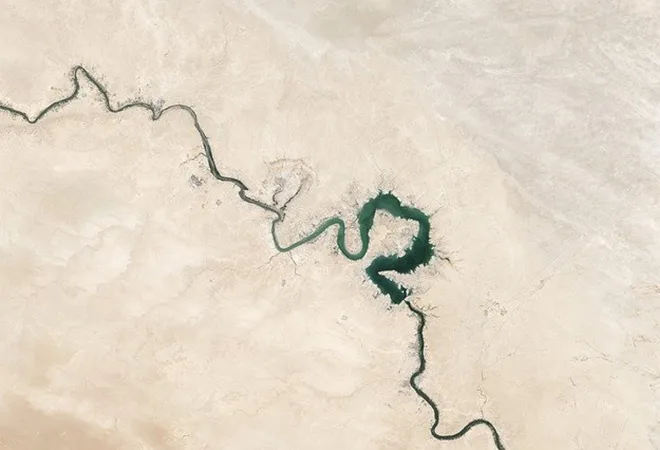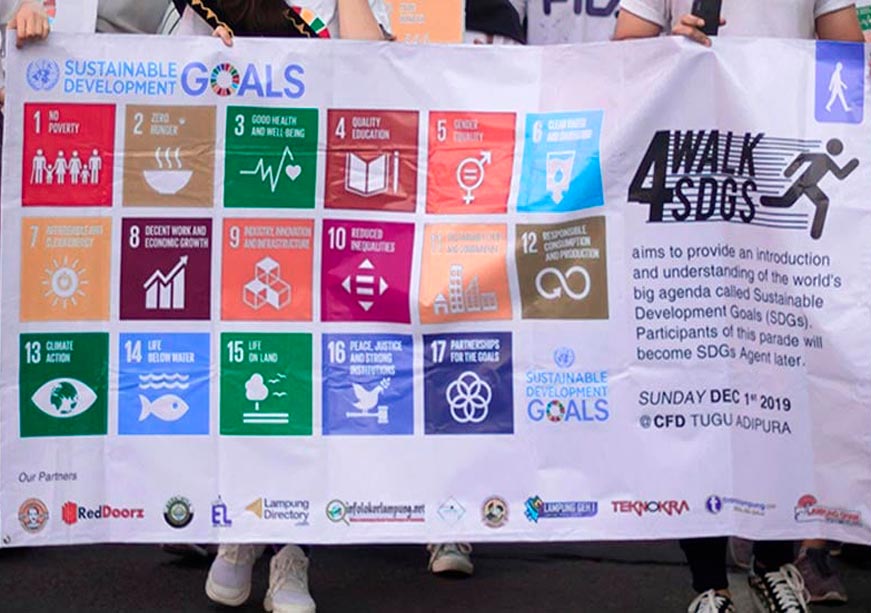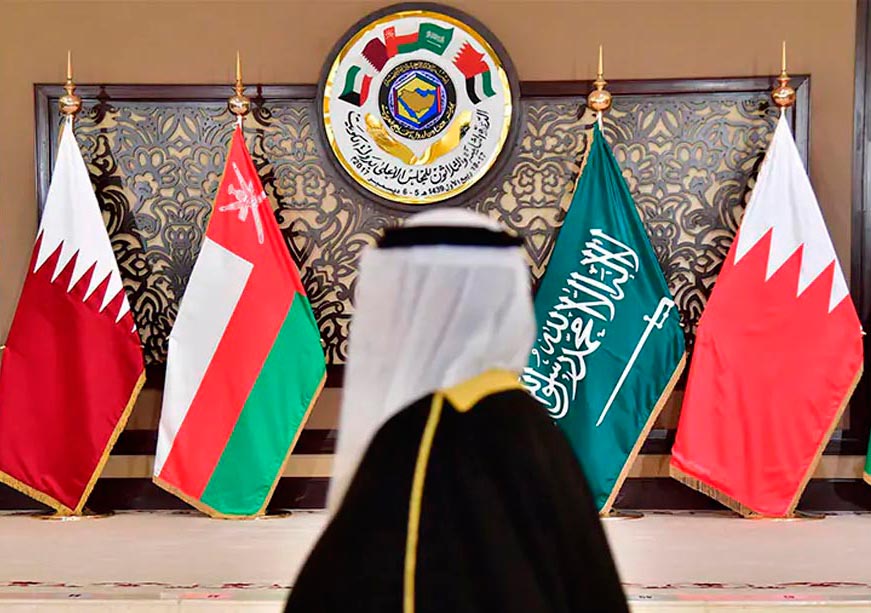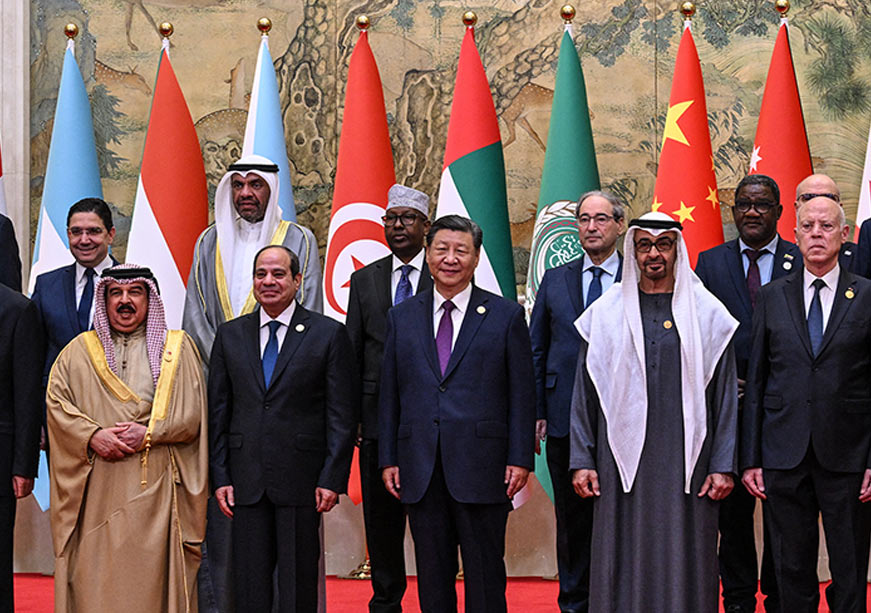This article is part of GP-ORF series — From Alpha Century to Viral World: The Raisina Young Fellows Speak.
The Middle East region is currently facing simultaneous security, climate change and water scarcity crises. Water scarcity is a pressing environmental issue in the Middle East and is increasingly becoming an additional source of conflict in the already unstable region. The region’s annual internal water resources amount to only 6 percent of its average annual precipitation, against a world average of 38 percent<1>. Home to about 6 percent of the world’s population, it has just 1 percent of the world’s freshwater resources. Nearly two-thirds of the region’s population live in areas that lack sufficient renewable water resources, and over 60 percent live in areas with high surface water stress compared to the global average of about 35 percent<2>. Meanwhile, nearly 70 percent of the Middle East’s economic activities are conducted in areas of high or very high water stress, more than three times the global average of 22 percent<3>. Despite the recent advances in water supply technology and management, extreme scarcity, poor governance, changing hydrology and ascending demands in different sectors are driving the overexploitation of the region’s scarce water resources. The high subsidies undermine incentives for efficient water management.
Although the Middle East has remarkable transboundary freshwater resources, the lack of mutual concession on water allocation in shared rivers and aquifers add a layer of complexity and potential conflict to the water scarcity situation in the region. Freshwater from the region’s main transboundary rivers — the Tigris-Euphrates, the Nile and the Jordan — are used for agricultural, industrial and domestic purposes at unsustainable volumes. However, most water policy measures are aimed at increasing access through further exploitation of aquifers or desalination of seawater, rather than at saving water and ensuring efficient management<4>.
The worsening water scarcity situation undermines human security and contributes to factors that increase the risks from violence, fragility and conflict, leading to insecurity and displacement throughout the Middle East. As a conflict-ridden regional system, Middle East geopolitics is characterised by failed states, political instability, forced displacement, military conflicts and chronic insecurity. Over the past decades, potential causes of insecurity have widened and diversified considerably in the region. Apart from traditional sources of tensions, socioeconomic and environmental issues increasingly contribute to causing and fueling conflict in the turbulent Middle East<5>. As trends in the region demonstrate, water scarcity combined with massive population growth and urbanisation is the most pressing environmental issue in the Middle East and is increasingly becoming an additional source of conflict in an already unstable region.
Power asymmetry and struggle for hydro-hegemony
As a strategic asset, water is no longer only linked to environmental issues and food security but also plays a critical role in regional security arrangements. States view water as a means for political leverage and as a source of power. Water in the Middle East is a source of state power, and water scarcity is highly intertwined with national security<6>. Many scholars have noted that conflicts over transboundary waters cannot be interpreted without understanding the power relations and the significance of upstream-downstream positioning of the competing or conflicting states<7>.
Historically, although power asymmetry is the main reason for the absence of wars in transboundary waters, it is also an important obstacle in adopting common measures and cooperative mechanisms in the basin for managing water scarcity. The severe imbalance of power among riparian states leads to an asymmetric allocation of transboundary waters and the absence of war does not imply the absence of conflict in the basin<8>. In the Middle East, the hydro-political conflict has occurred when downstream states are weak and unable to adapt to water scarcity, and where the relative strength is extremely asymmetric — for example, between Israel and Palestine or Turkey and Iraq.
According to the framework of hydro-hegemony — an analytical structure to study how hegemony and power asymmetries influence transboundary water politics — relative power imbalance inevitably leads to hydro-hegemony in the basin, in which a superior power controls water flows and forces weaker states to follow its instructions<9>. Power in its greatest form determines who the hegemon is. The hegemon has an asymmetric capacity to coerce a weaker state and writes the agenda for all riparian states within the river basin. Apart from the geographical position, the framework suggests that the use of force and consent tied together with the enforcement of rules on a basin is a stronger determinant than international laws on the non-navigational use of international watercourses or riparian position. Upstream states use water to garner more power, while downstream countries use power to source more water — Turkey, for instance, is an upstream hegemon; Ethiopia is an upstream state but is not a hegemon; Egypt, on the other hand, is a downstream hegemon. In this context, the international water law has been manipulated by the powerful riparian for power expression and to urge compliance<10>.
In asymmetric circumstances, when the upstream state is the basin’s hegemon, cooperation is least likely to materialise. In contrast, when the downstream state is the basin’s hegemon, cooperation is likely to proceed, yet the agreement is often imposed along the benefits of the stronger riparian<11>. For example, the strategic location and hydro-hegemony of Turkey on the Euphrates and Tigris, and Israel on the Jordan River allow the countries to maintain an upper hand over Syria and Iraq, and Palestine, respectively. Although power relations of basin states evolve through coexisting, conflictual and cooperative interactions, efficient transboundary water management that facilitates cooperation is hard to attain. In the context of asymmetric power in the basin, where water governance is applied as water is perceived as a public good, the hydro-hegemon dictates the mechanism of cooperative adaptation to the weaker riparian in a coercive engagement. Under the running asymmetries in power over the region’s main transboundary rivers — the Tigris, Euphrates and the Jordan — the weak downstream riparian states are apparently unable to change the arrangements, which leaves no room for negotiation and reconciliation while escalating the rising water conflict in the Middle East.
Beyond borders: Emerging international security threat
Transboundary water arrangements are inherently political and determined by the broader social-security context of riparian states. In the Middle East, which continuously suffers from chronic disorder, water supply systems are increasingly becoming both political lever and objectives of strategic action as states perceive access to water as an issue of national security. Therefore, the maldistribution of transboundary freshwater combined with growing populations and urbanisation, the absence of the rule of international water law and dwindling water resources demonstrate that water is becoming an increasingly critical trigger of interstate politics and conflict. In semi-arid zones such as the Middle East, war over water is highly probable as the hydro-hegemony is building massive dams over shared rivers, effectively weaponising water to achieve their strategic interests.
In recent decades, Turkey has pursued the vast and ambitious Southeastern Anatolia Project that entails the construction of 22 dams on the Tigris and Euphrates, curtailing nearly 80 percent of water flow into Iraq and Syria<12>. For Turkey, hydro-dams are not just sources of energy and revenue, but potent levers of geopolitical pressure to shape the security arrangements in the Levant and Iraq, aimed at Kurdish politics. By controlling 90 percent and 44 percent, respectively, of the water flows of the Euphrates and the Tigris, Ankara refuses to be bound by international treaties and dismisses its neighbours’ demands for a formal water-sharing agreement to regulate the flows in the basin<13>. Given the backdrop of political tensions arising from Turkey’s incursions into northern Syria and Iraq, there is also a risk that Ankara will increasingly use water as a weapon in a future conflict with its regional rivals and neighbours.
The situation is similar in the Nile and the Jordan transboundary basin; Egypt and Israel have been manipulating ongoing turmoil to push their ambitious agenda to be regional hydro-hegemons<14>. Power asymmetry in the Jordan River basin and advanced technology enables Israel to seize the water resources in Palestine and neighbouring Arab countries, as water can be used as a determinant lever in Israel’s continuing occupation of the West Bank. Apart from being used as a domination tool, water conflict has indeed been the main trigger in wars, such as the Six Day War in 1967. A growing number of studies also show that water scarcity, drought and climate change have played a direct role in the deterioration of Syrian socioeconomic conditions and violent civil war, as well as the emergence of extremist armed groups in Iraq or Syria, such as ISIS<15>.
Water scarcity in the Middle East is an issue of global importance, transforming conflict among riparian states into key regional and international security concerns. Water scarcity is a threat multiplier and its socioeconomic effects have serious implications for international security — aggravating factors can lead to massive displacement and migration flows, pressing concerns for food security, environmental degradation, political instability, social insurgency, state failure, interstate violent conflict and the re-emergence of extremism and terrorism, with all capable of triggering domino effects outside the region.
International communities and water-related institutions should initiate and advocate a constructive political dialogue among the riparian states, aiming at international cooperation to pave the way for sustainable solutions to water scarcity in the Middle East. To initiate an effective international cooperation and reconciliation, water scarcity in the region should first be recognised as the most worrisome security threat due to its profound destabilising potential and domino effects. Multilateral initiatives should be built upon the establishment of transboundary water resource management agreements, which help navigate local political barriers and may lead to the adoption of an integrated framework to manage water demand and supply in the longer term.
While cooperation and negotiation may not be welcomed by all riparian states, the constructive involvement of foreign powers and institutions can balance the negotiating field in the basin, encourage hydro-hegemons to consider water as a public good and facilitate an effective transboundary water governance in the Middle East. Along with recalibrating national water strategies and management by riparian states, water diplomacy is likely to become increasingly determinant. To do so, the international community and institutions, like the European Union, can provide financial and technical support to boost cross-border cooperation. They can moderate and facilitate negotiations among riparian nations, initiate and lead regional cooperation platforms and monitor the implementation of treaties as a third party.
If current trends persist, there is a significant risk of imminent conflicts and wars over water in this region, with vast spillover impacts. The international community must act now.
Endnotes
<1> UNDP-RBAS and Sida, Water Governance in the Arab Region: Managing Scarcity and Securing the Future, New York, UNDP-RBAS, 2013.
<2> Beyond Scarcity: Water Security in the Middle East and North Africa (Washington, DC: World Bank Publications, 2018), pp. 9–11.
<3> “Beyond Scarcity,” pp. 10–14
<4> Johan Schaar, “A Confluence of Crises: on Water, Climate and Security in the Middle East and North Africa,” SIPRI Insights on Peace and Security, no. 2019/4 (2019).
<5> Tareq Baconi, Testing the Water: How Water Scarcity Could Destabilize the Middle East and North Africa (London: European Council on Foreign Relations, 2018), pp. 4–7.
<6> Mark Zeitoun, Power and Water: The Hidden Politics of the Palestinian-Israeli Conflict (London: I.B. Tauris, 2008), pp. 113-126.
<7> Mark Zeitoun and John Anthony Allan, “Applying hegemony and power theory to transboundary water analysis,” Water Policy 10 (2008): 3–12; Filippo Menga, “Reconceptualizing hegemony: The circle of hydrohegemony,” Water Policy 18 (2006): 401–418.
<8> Zeitoun and Allan, “Applying hegemony,” 8
<9> Mark Zeitoun and Jeroen Warner, “Hydro-hegemony: A Framework for Analysis of Trans-boundary Water Conflicts,” Water Policy 8 (2006): 435–460.
<10> Melvin Woodhouse and Mark Zeitoun, “Hydro-hegemony and international water law: grappling with the gaps of power and law,” Water Policy 10 (S2) (2018): 103–119.
<11> Zeitoun, “Power and Water,” pp. 34
<12> Paul Hockenos, “Turkey’s Dam-Building Spree Continues, At Steep Ecological Cost,” Yale Environment 360, Yale School of the Environment, 3 October 2019.
<13> Connor, Dilleen, “Turkey’s dam-building program could generate fresh conflict in the Middle East,” The Strategist, Australian Strategic Policy Institute, 5 November 2019.
<14> Semih Kuhalah, “Water troubles in Israel and their influence on the Arab-Israeli conflict,” The Institute for Palestine Studies, Beirut, Paper no. 9 (2020): 5–7.
<15> Amjad Al Adaylah, Conflict on Water in the Middle East War and Peace (Amman: Dar El Shorouk Publication, 2020), pp. 112–117; Peter H. Gleick, “Water, Drought, Climate Change, and Conflict in Syria,” Weather, Climate, and Society, 6(3) (July 2014), pp. 331–340.












